Winter Dew Harvest in Mexico City
Abstract
:1. Introduction
2. Materials and Methods
2.1. Materials and Climate
2.2. Modeling
2.2.1. Theoretical Modeling
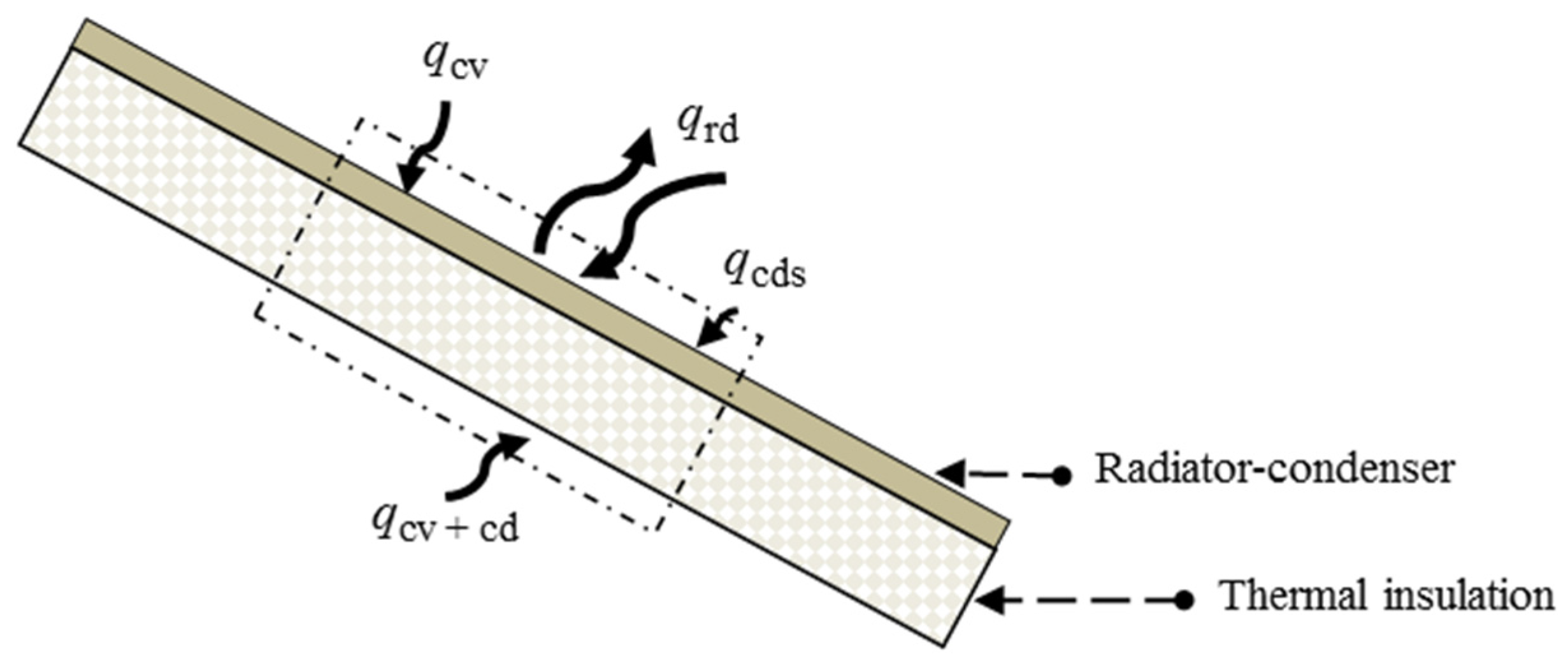
2.2.2. Experimental Model

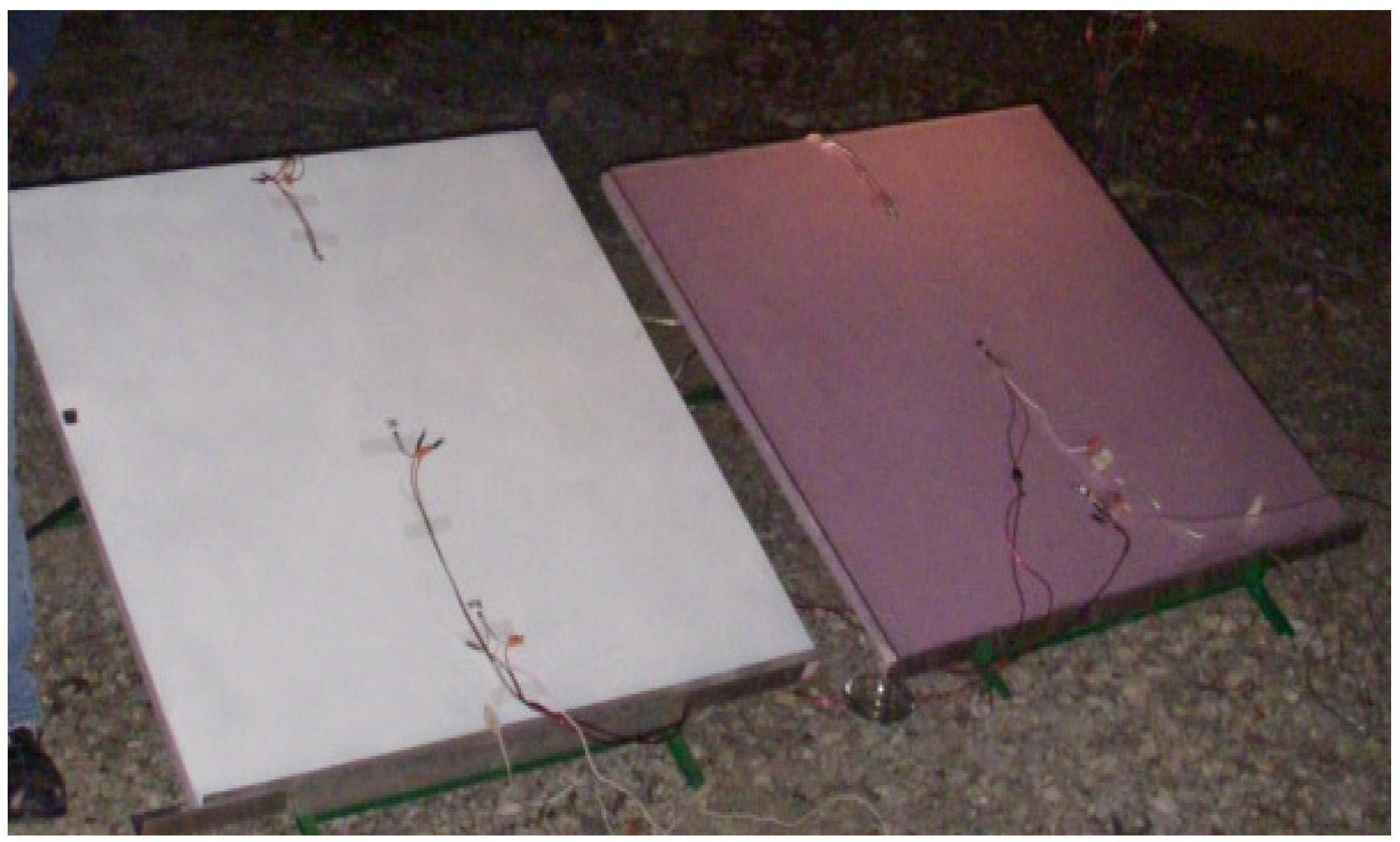
2.2.3. Experimental Procedure
3. Results and Discussion
3.1. Experimental Results
3.1.1. Winter Dew Harvest
| -- | 21–31 December | 1–31 January | 1–29 February | 1–21 March | Winter | |||||
|---|---|---|---|---|---|---|---|---|---|---|
| -- | min | max | min | max | min | max | min | max | min | max |
| Ta (°C) | 4.2 | 9 | 4 | 10 | 6.2 | 12 | 7.5 | 13 | 4 | 13 |
| RH (%) | 61 | 81 | 47 | 85 | 60 | 90 | 47 | 90 | 47 | 90 |
3.1.2. Hourly Dew Harvest during a Representative Winter Night
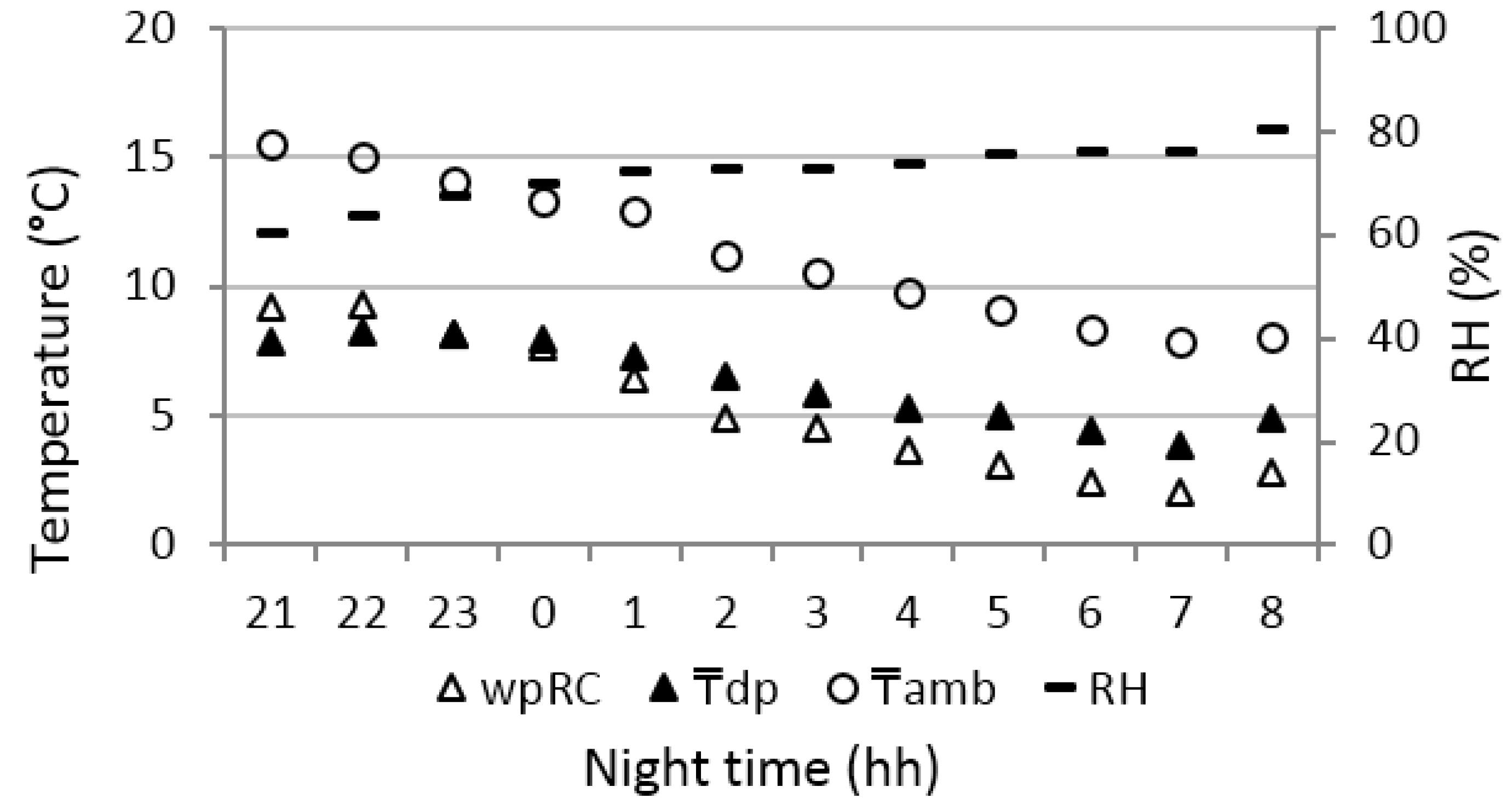
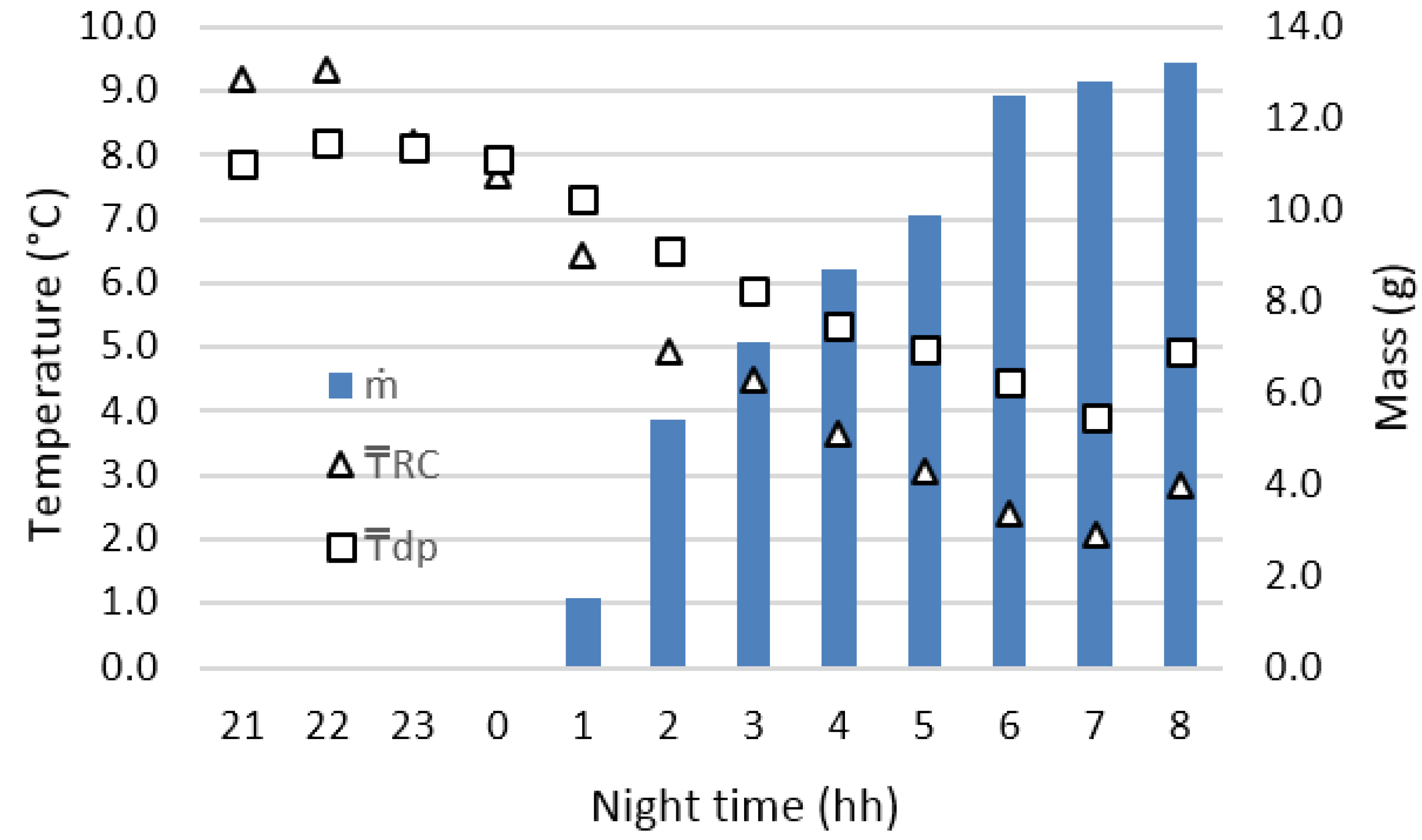
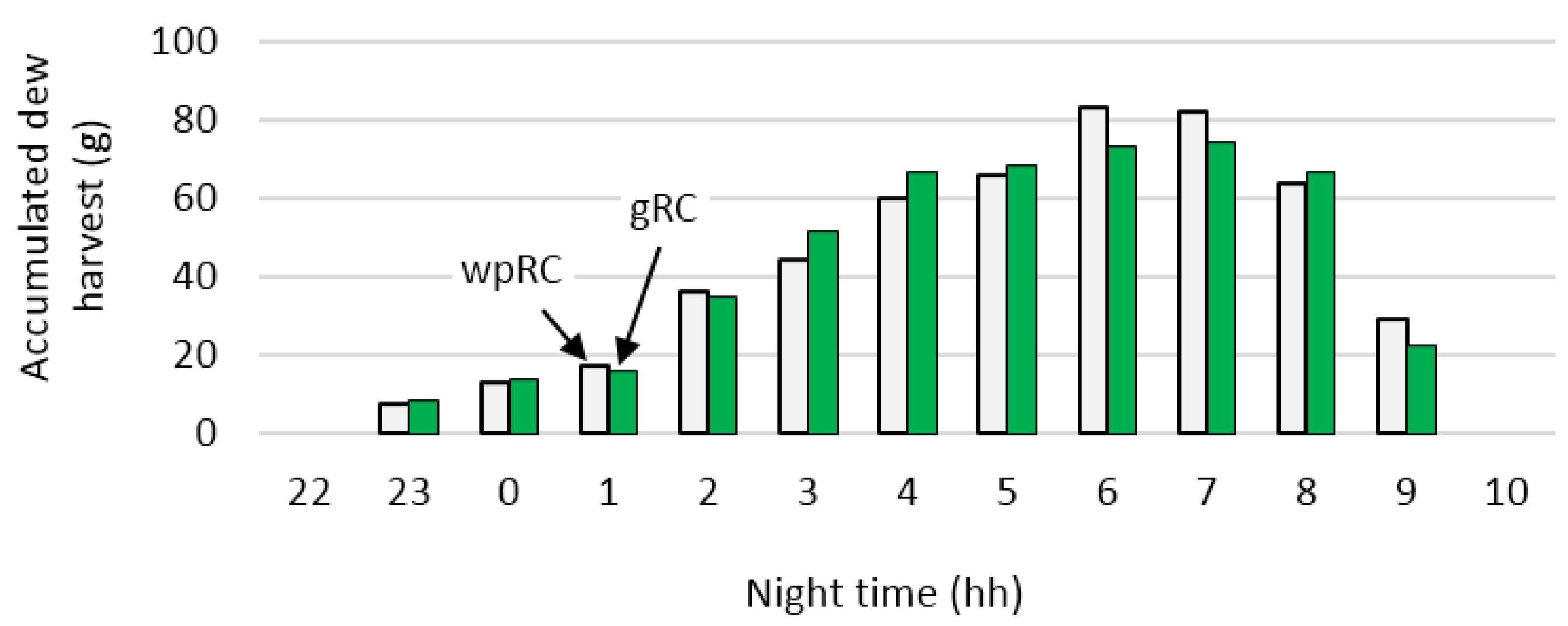
3.1.3. Nightly Radiative Cooling throughout Winter
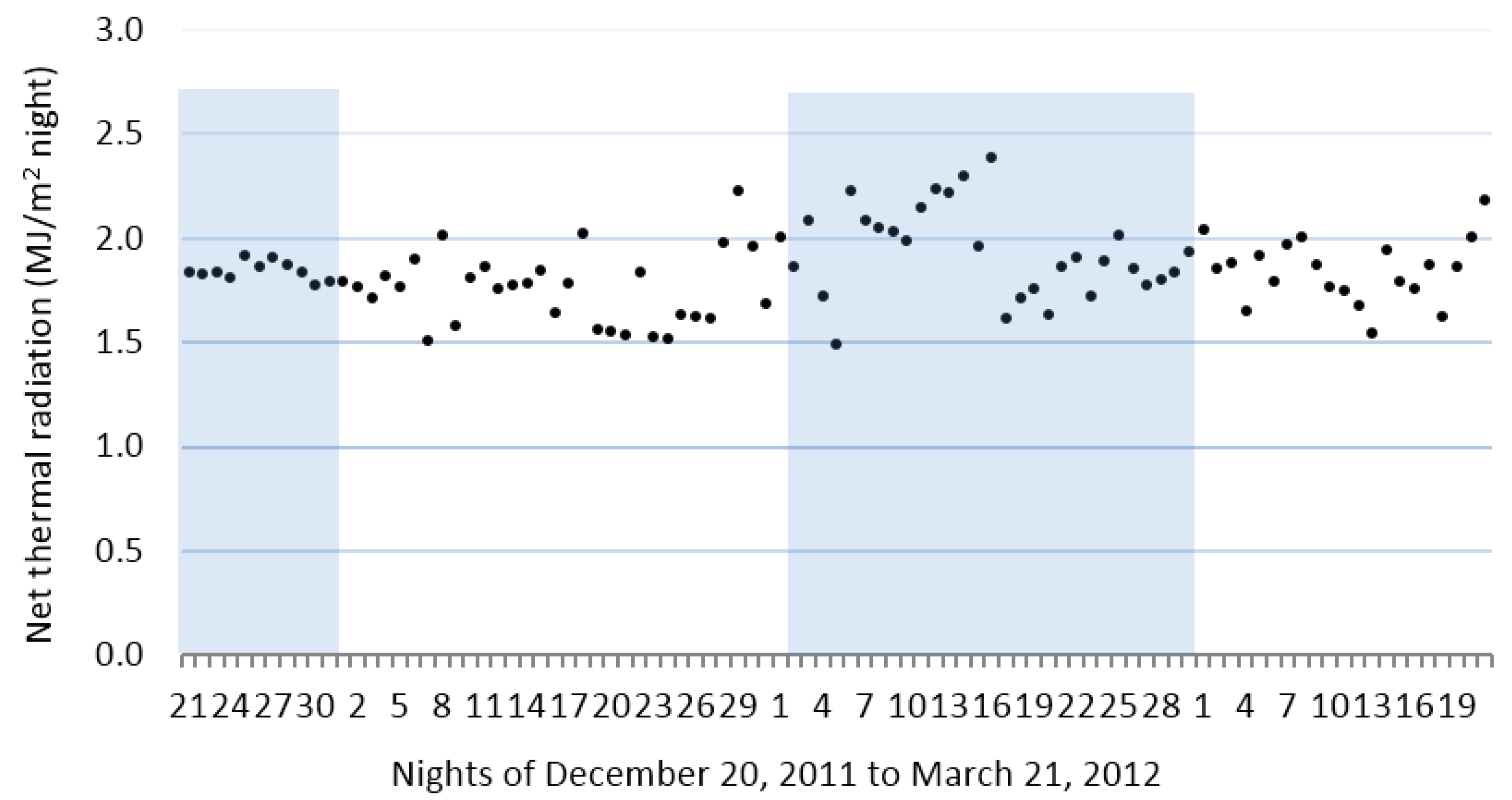
3.1.4. Nightly Dew Harvest throughout the Winter
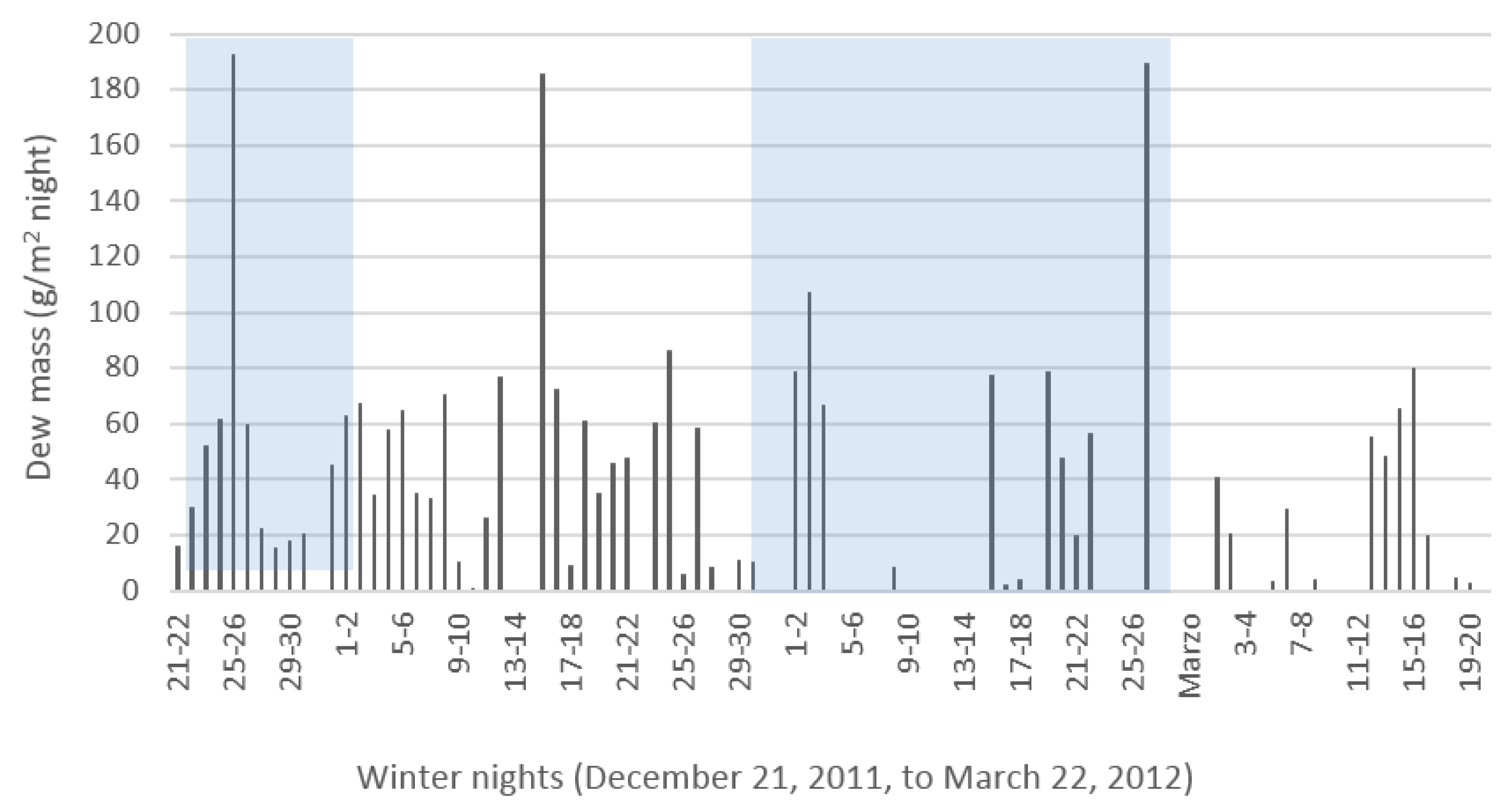
3.1.5. Monthly and Winter Dew Harvest
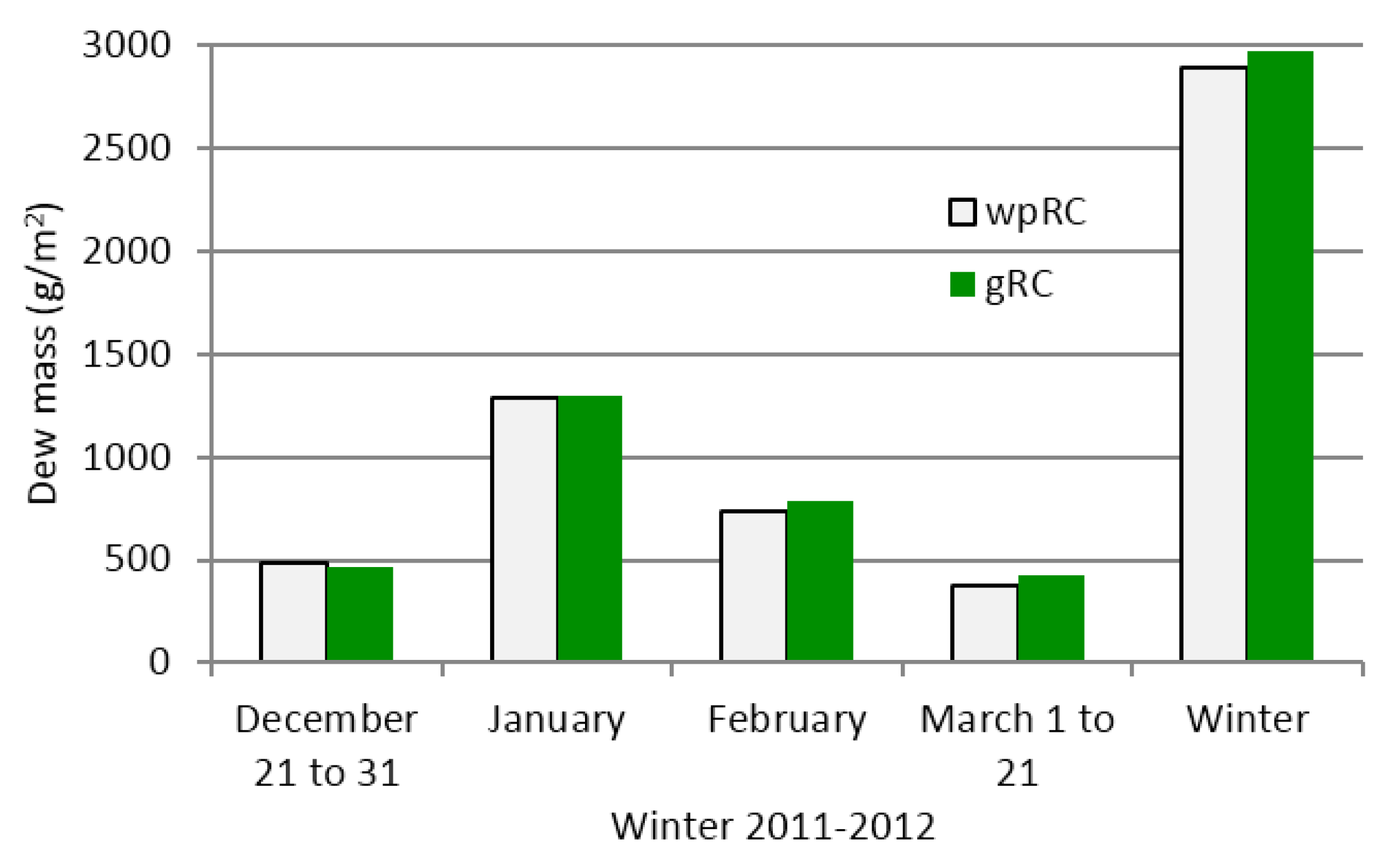
3.2. Model Prediction
3.2.1. Hourly Dew Harvest Predictions of Representative Nights
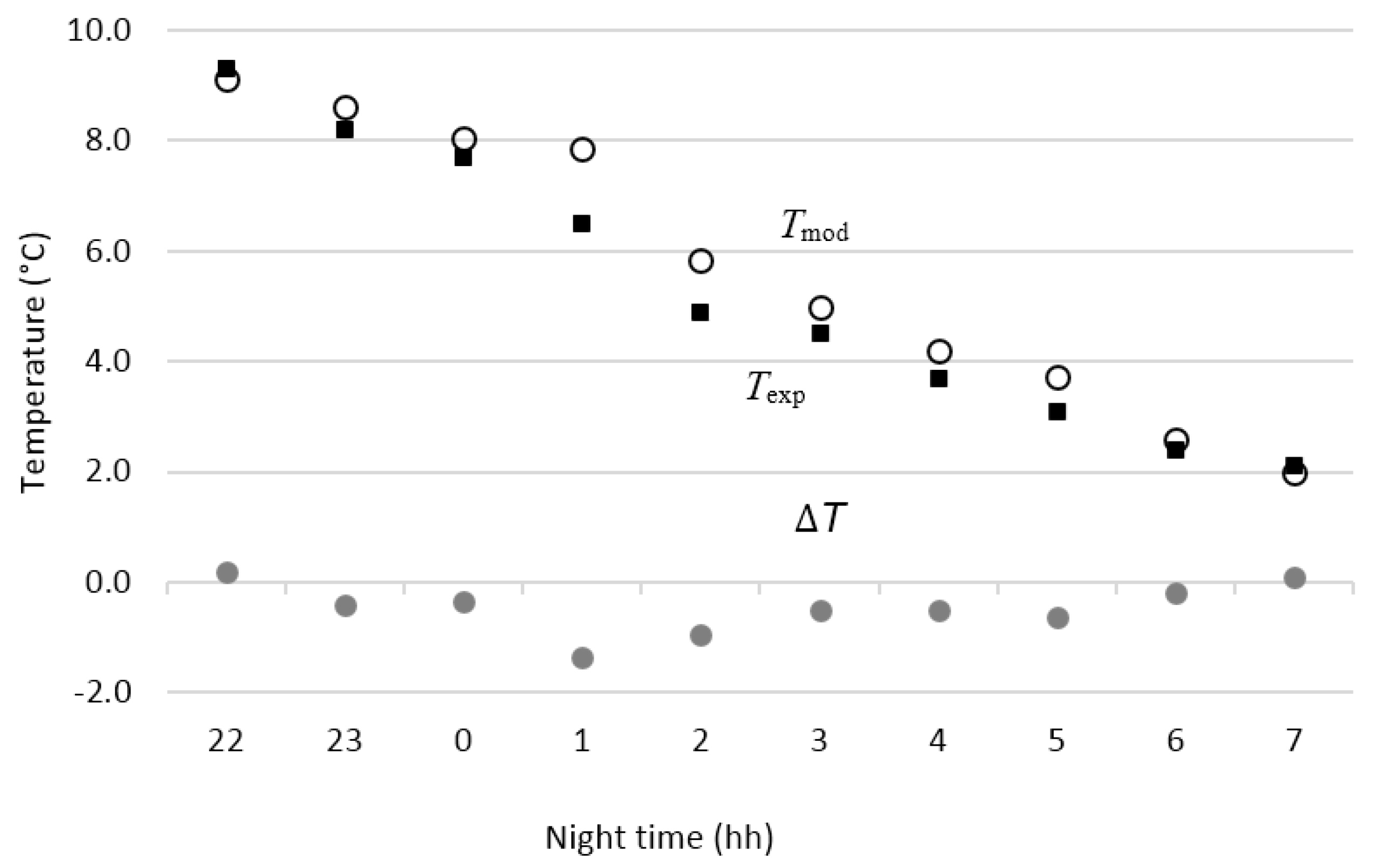
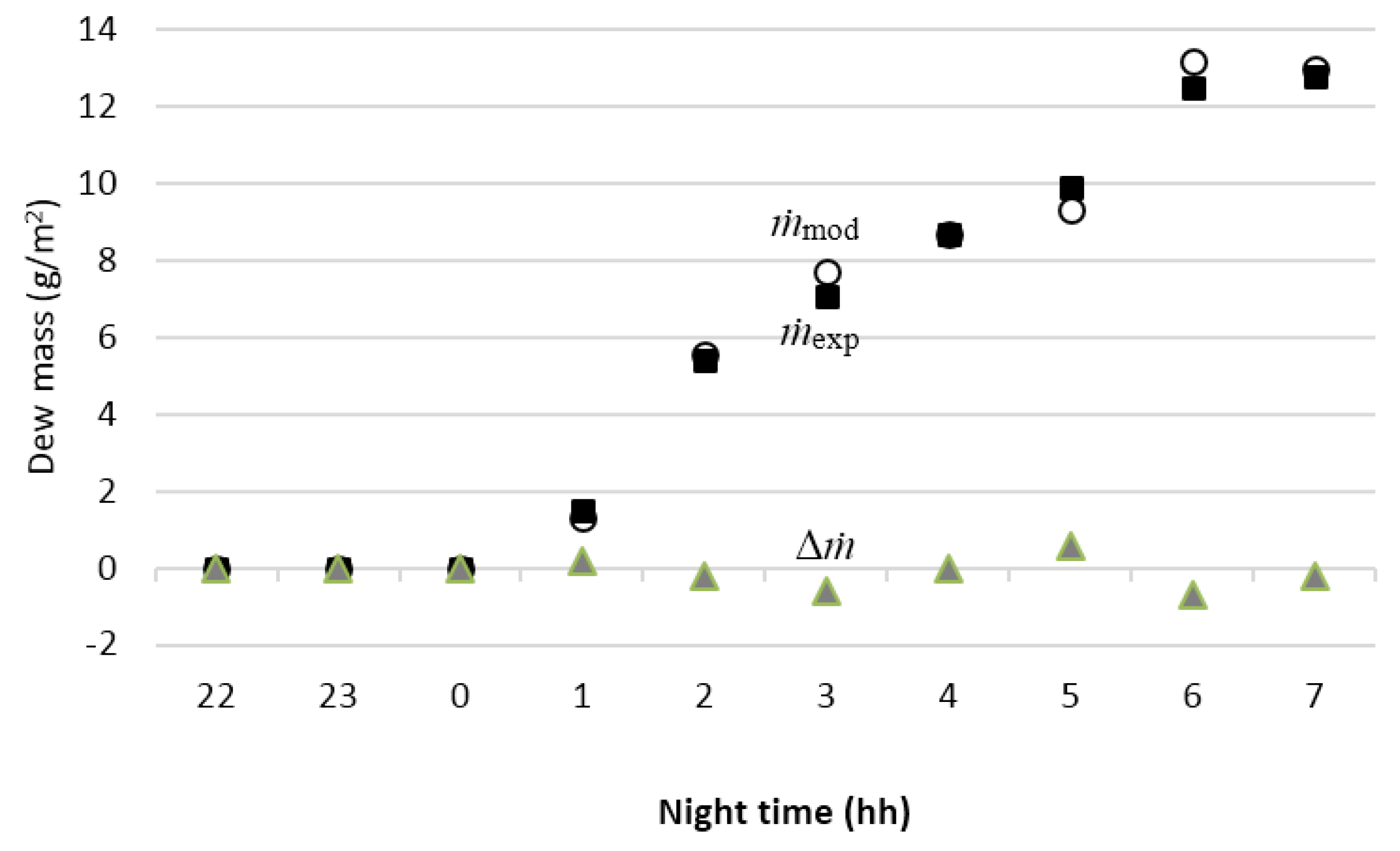
3.2.2. Nightly Prediction of Winter Dew Harvest
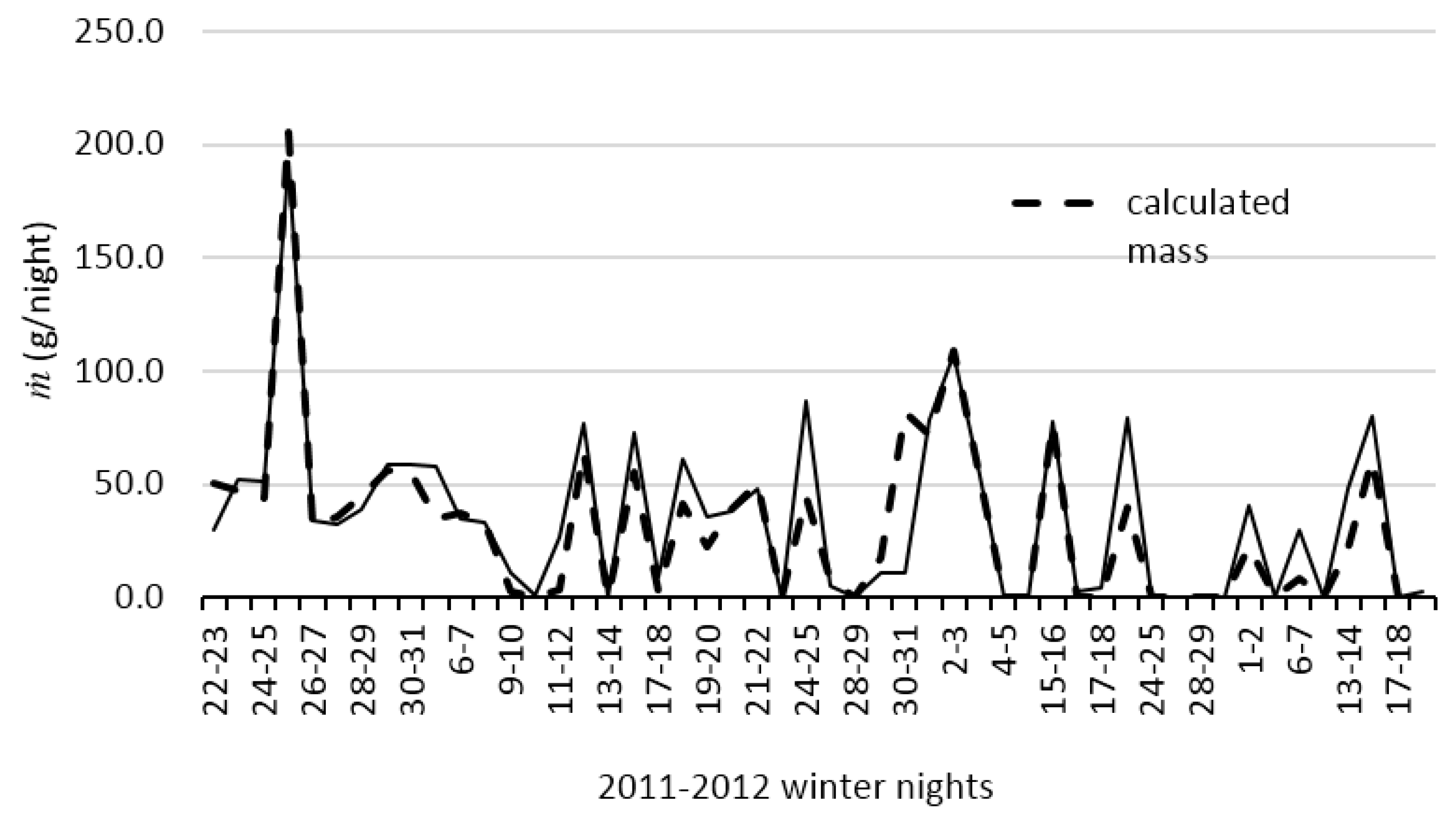
4. Conclusions
Acknowledgments
Author Contributions
Conflicts of Interest
References
- Rosegrant, M.W.; Cai, X.; Cline, S.A. Global Water Outlook to 2025. Averting an Impending Crisis. A 2020 Vision for Food, Agriculture and the Environment Initiative. Available online: www.ifpri.cgiar.org/sites/default/files/pubs/pubs/fpr/fprwater 2025.pdf (accessed on 25 April 2014).
- Lekouch, I.; Muselli, M.; Kabbachi, B.; Ouazzani, J.; Melnytchouk-Milimouk, I.; Beysens, D. Dew, fog, and rain as supplementary sources of water in southwestern Morocco. Energy 2011, 36, 2257–2265. [Google Scholar] [CrossRef]
- Nikolayev, V.S.; Beysens, D.; Gioda, A.; Milimouk, I.; Katiushin, E.; Morel, J.P. Water recovery from dew. J. Hydrol. 1996, 182, 19–35. [Google Scholar] [CrossRef]
- Nilsson, T.; Vargas, W.E.; Niklasson, G.A.; Granqvist, C.G. Condensation of water by radiative cooling. Renew. Energy 1994, 5, 310–317. [Google Scholar] [CrossRef]
- Nilsson, T. Initial experiments on dew collection in Sweden and Tanzania. Sol. Energy Mater. Sol. Cells 1996, 40, 23–32. [Google Scholar] [CrossRef]
- Alnaser, W.E.; Barakat, A. Use of condensed water vapour from the atmosphere for irrigation in Bahrain. Appl. Energy 2000, 65, 3–18. [Google Scholar] [CrossRef]
- Beysens, D.; Milimouk, I.; Nikolayev, V.; Muselli, M.; Marcillat, J. Using radiative cooling to condense atmospheric vapor: A study to improve water yield. J. Hydrol. 2003, 276, 1–11. [Google Scholar] [CrossRef]
- Berkowicz, S.M.; Beysens, D.; Milimouk, I.; Heusinkveld, B.G.; Muselli, M.; Wakshal, E.; Jacobs, A.F.G. Urban Dew Collection Under Semi-arid Conditions: Jerusalem. In Proceedings of the Third International Conference on Fog, Fog Collection and Dew, Cape Town, South Africa, 11–15 October 2004.
- Gandhidasan, P.; Abualhamayel, H.I. Modeling and testing of a dew collection system. Desalination 2005, 180, 47–51. [Google Scholar] [CrossRef]
- Muselli, M.; Beysens, D.; Mileta, M.; Milimouk, I. Dew and rainwater collection in the Dalmatian Coast, Croatia. Atmos. Res. 2009, 92, 455–463. [Google Scholar] [CrossRef]
- Beysens, D.; Lekouch, I.; Mileta, M.; Milimouk, I.; Muselli, M. Dew and Rain Water Collection in South Croatia. Int. J. Environ. Sci. Eng. 2009, 1, 64–70. [Google Scholar]
- Sharan, G.; Singh, S.; Clus, O.; Milimouk-Melnytchouk, I.; Muselli, M.; Beysens, D. Roofs as dew collectors: III. Special Polyethylene foil on a school in Sayara (NW India). In Proceedings of the Fourth International Conference on Fog, Fog Collection and Dew, La Serena, Chile, 23–27 July 2007.
- Jacobs, A.F.G.; Heusinkveld, B.G.; Berkowicz, S.M. Passive dew collection in a grassland area, The Netherlands. Atmos. Res. 2008, 87, 377–385. [Google Scholar] [CrossRef]
- Mileta, M.; Beysens, D.; Nikolayev, V.; Milimouk, I.; Clus, O.; Muselli, M. Fog and Dew Collection Projects in Croatia. In Proceedings of the International Conference on “Water Observation and Information System for Decision Support” (BALWOIS 2006), Ohrid, Macedonia, 23–26 May 2006.
- Sharan, G.; Beysens, D.; Milimouk-Melnytchouk, I. A study of dew water yields on Galvanized iron roofs in Kothara (North-West India). J. Arid Environ. 2007, 69, 259–269. [Google Scholar] [CrossRef]
- Maestre-Valero, J.F.; Martinez-Alvarez, V.; Baille, A.; Martín-Górriz, B.; Gallego-Elvira, B. Comparative analysis of two polyethylene foil materials for dew harvesting in a semi-arid climate. J. Hydrol. 2011, 410, 84–91. [Google Scholar] [CrossRef]
- Vuollekoski, H.; Vogt, M.; Sinclair, V.A.; Duplissy, J.; Järvinen, H.; Kyrö, E.M.; Makkonen, R.; Petäjä, T.; Prisle, N.L.; Räisänen, P.; et al. Estimates of global dew collection potential on artificial surfaces. Hydrol. Earth Syst. Sci. 2015, 19, 601–613. [Google Scholar] [CrossRef]
- Maestre-Valero, J.F.; Ragab, R.; Martínez-Alvarez, V.; Baille, A. Estimation of dew yield from radiative condensers by means of an energy balance model. J. Hydrol. 2012, 460–461, 103–109. [Google Scholar] [CrossRef]
- Beysens, D. Estimating dew yield worldwide from a few meteo data. Atmos. Res. 2016, 167, 146–155. [Google Scholar] [CrossRef]
- CONEVYT. Secretaría de Educación Pública, México. Clasificación y distribución de los climas en México. Available online: http://www.conevyt.org.mx/cursos/cursos/cnaturales_v2/interface/main/recursos/antología/cnant_4_13.htm (accessed on 24 April 2013).
- Berel Painting Datasheet. Available online: http://www.berel.com.mx/mobile/hojasseguridad/BA100acryl.pdf (accessed on 12 January 2012).
- Weather Underground. Climas Históricos de la Ciudad de México MMMX. Available online: www.wunderground.com/personal-weather-station/dashboard?ID=IDFMEXIC8#history/tdata/s20111223/e20120321/mcustom (accessed 24 April 2013).
- Beysens, D.; Muselli, M.; Nikolayev, V.; Narhe, R.; Milimouk, I. Measurement and modelling of dew in island, coastal and alpine areas. Atmos. Res. 2005, 73, 1–22. [Google Scholar] [CrossRef]
- Tang, R.; Etzion, Y.; Meir, I.A. Estimates of clear night sky emissivity in the Negev Highlands, Israel. Energy Convers. Manag. 2004, 45, 1831–1843. [Google Scholar] [CrossRef]
- Lawrence, M.G. The relationship between relative humidity and the dew point temperature in moist air: A simple conversion and applications. Bull. Am. Meteor. Soc. 2005, 86, 225–233. [Google Scholar] [CrossRef]
- Rakovec, J.; Zaksek, K. On the proper analytical expression for the sky-view factor and the diffuse irradiation of a slope for an isotropic sky. Renew. Energy 2012, 37, 440–444. [Google Scholar] [CrossRef]
- Báez, A.; Belmont, R.; García, R.; Padilla, H.; Torres, M.C. Chemical composition of rainwater collected at a southwest site of Mexico City, Mexico. Atmos. Res. 2007, 86, 61–75. [Google Scholar] [CrossRef]
© 2015 by the authors; licensee MDPI, Basel, Switzerland. This article is an open access article distributed under the terms and conditions of the Creative Commons by Attribution (CC-BY) license (http://creativecommons.org/licenses/by/4.0/).
Share and Cite
Jorge Ernesto, A.-T.; Jose Jasson, F.-P. Winter Dew Harvest in Mexico City. Atmosphere 2016, 7, 2. https://doi.org/10.3390/atmos7010002
Jorge Ernesto A-T, Jose Jasson F-P. Winter Dew Harvest in Mexico City. Atmosphere. 2016; 7(1):2. https://doi.org/10.3390/atmos7010002
Chicago/Turabian StyleJorge Ernesto, Arias-Torres, and Flores-Prieto Jose Jasson. 2016. "Winter Dew Harvest in Mexico City" Atmosphere 7, no. 1: 2. https://doi.org/10.3390/atmos7010002
APA StyleJorge Ernesto, A.-T., & Jose Jasson, F.-P. (2016). Winter Dew Harvest in Mexico City. Atmosphere, 7(1), 2. https://doi.org/10.3390/atmos7010002





